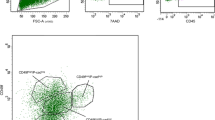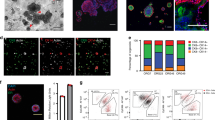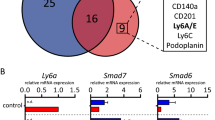Abstract
Elucidation of the cellular and molecular mechanisms that maintain mammary epithelial tissue integrity is of broad interest and paramount to the design of more effective treatments for breast cancer1. Evidence from both in vitro and in vivo experiments suggests that mammary cell differentiation is a hierarchical process originating in an uncommitted stem cell with self-renewal potential2,3,4. However, analysis of the properties and regulation of mammary stem cells has been limited by a lack of methods for their prospective isolation. Here we report the use of multi-parameter cell sorting and limiting dilution transplant analysis to demonstrate the purification of a rare subset of adult mouse mammary cells that are able individually to regenerate an entire mammary gland within 6 weeks in vivo while simultaneously executing up to ten symmetrical self-renewal divisions. These mammary stem cells are phenotypically distinct from and give rise to mammary epithelial progenitor cells that produce adherent colonies in vitro. The mammary stem cells are also a rapidly cycling population in the normal adult and have molecular features indicative of a basal position in the mammary epithelium.
This is a preview of subscription content, access via your institution
Access options
Subscribe to this journal
Receive 51 print issues and online access
$199.00 per year
only $3.90 per issue
Buy this article
- Purchase on SpringerLink
- Instant access to full article PDF
Prices may be subject to local taxes which are calculated during checkout




Similar content being viewed by others
References
Al Hajj, M. & Clarke, M. F. Self-renewal and solid tumour stem cells. Oncogene 23, 7274–7282 (2004)
Kordon, E. C. & Smith, G. H. An entire functional mammary gland may comprise the progeny from a single cell. Development 125, 1921–1930 (1998)
Dontu, G. et al. In vitro propagation and transcriptional profiling of human mammary stem/progenitor cells. Genes Dev. 17, 1253–1270 (2003)
Stingl, J., Raouf, A., Emerman, J. T. & Eaves, C. J. Epithelial progenitors in the normal human mammary gland. J. Mamm. Gland Biol. Neoplasia 10, 49–59 (2005)
Sakakura, T. in The Mammary Gland: Development, Regulation, and Function (eds Neville, M. C. & Daniel, C. W.) 37–66 (Plenum, New York, 1987)
Smalley, M. J., Titley, J. & O'Hare, M. J. Clonal characterization of mouse mammary luminal epithelial and myoepithelial cells separated by fluorescence-activated cell sorting. In Vitro Cell. Dev. Biol. Anim. 34, 711–721 (1998)
Stingl, J., Eaves, C. J., Zandieh, I. & Emerman, J. T. Characterization of bipotent mammary epithelial progenitor cells in normal adult human breast tissue. Breast Cancer Res. Treat. 67, 93–109 (2001)
Smith, G. H. Experimental mammary epithelial morphogenesis in an in vivo model: evidence for distinct cellular progenitors of the ductal and lobular phenotype. Breast Cancer Res. Treat. 39, 21–31 (1996)
Wagers, A. J., Sherwood, R. I., Christensen, J. L. & Weissman, I. L. Little evidence for developmental plasticity of adult hematopoietic stem cells. Science 297, 2256–2259 (2002)
Hadjantonakis, A. K., Macmaster, S. & Nagy, A. Embryonic stem cells and mice expressing different GFP variants for multiple non-invasive reporter usage within a single animal. BMC Biotechnol. 2, 11 (2002)
Wlem, B. E. et al. Sca-1pos cells in the mouse mammary gland represent an enriched progenitor cell population. Dev. Biol. 245, 42–56 (2002)
Tani, H., Morris, R. J. & Kaur, P. Enrichment for murine keratinocyte stem cells based on cell surface phenotype. Proc. Natl Acad. Sci. USA 97, 10960–10965 (2000)
Li, A., Simmons, P. J. & Kaur, P. Identification and isolation of candidate human keratinocyte stem cells based on cell surface phenotype. Proc. Natl Acad. Sci. USA 95, 3902–3907 (1998)
Jones, C. et al. Expression profiling of purified normal human luminal and myoepithelial breast cells: identification of novel prognostic markers for breast cancer. Cancer Res. 64, 3037–3045 (2004)
Carter, W. G., Kaur, P., Gil, S. G., Gahr, P. J. & Wayner, E. A. Distinct functions for integrins alpha 3 beta 1 in focal adhesions and alpha 6 beta 4/bullous pemphigoid antigen in a new stable anchoring contact (SAC) of keratinocytes: relation to hemidesmosomes. J. Cell Biol. 111, 3141–3154 (1990)
Shackleton, M. et al. Generation of a functional mammary gland from a single stem cell. Nature 439, 84–88 (2006)
Li, Y. et al. Evidence that transgenes encoding components of the Wnt signaling pathway preferentially induce mammary cancers from progenitor cells. Proc. Natl Acad. Sci. USA 100, 15853–15858 (2003)
Goodell, M. A., Brose, K., Paradis, G., Conner, A. S. & Mulligan, R. C. Isolation and functional properties of murine hematopoietic stem cells that are replicating in vivo. J. Exp. Med. 183, 1797–1806 (1996)
Zhou, S. et al. The ABC transporter Bcrp1/ABCG2 is expressed in a wide variety of stem cells and is a molecular determinant of the side-population phenotype. Nature Med. 7, 1028–1034 (2001)
Spangrude, G. J. & Johnson, G. R. Resting and activated subsets of mouse multipotent hematopoietic stem cells. Proc. Natl Acad. Sci. USA 87, 7433–7437 (1990)
Uchida, N. et al. ABC transporter activities of murine hematopoietic stem cells vary according to their developmental and activation status. Blood 103, 4487–4495 (2004)
Bhattacharya, S. et al. Direct identification and enrichment of retinal stem cells/progenitors by Hoechst dye efflux assay. Invest. Ophthalmol. Vis. Sci. 44, 2764–2773 (2003)
Hierlihy, A. M., Seale, P., Lobe, C. G., Rudnicki, M. A. & Megeney, L. A. The post-natal heart contains a myocardial stem cell population. FEBS Lett. 530, 239–243 (2002)
Alvi, A. J. et al. Functional and molecular characterisation of mammary side population cells. Breast Cancer Res. 5, R1–R8 (2003)
Smith, G. H. Label-retaining epithelial cells in mouse mammary gland divide asymmetrically and retain their template DNA strands. Development 132, 681–687 (2005)
Glimm, H., Oh, I. & Eaves, C. Human hematopoietic stem cells stimulated to proliferate in vitro lose engraftment potential during their S/G2/M transit and do not reenter G0 . Blood 96, 4185–4193 (2000)
Stingl, J., Emerman, J. T. & Eaves, C. J. in Methods in Molecular Biology: Basic Cell Culture Protocols (eds Helgason, C. D. & Miller, C. L.) 249–263 (Humana, New Jersey, 2005)
Young, L. J. T. in Methods in Mammary Gland Biology and Breast Cancer Research (eds Ip, M. M. & Asch, B. B.) 67–74 (Kluwer/Plenum, New York, 2000)
Szilvassy, S. J., Nicolini, F. E., Eaves, C. J. & Miller, C. L. in Methods in Molecular Medicine: Hematopoietic Stem Cell Protocols (eds Jordon, C. T. & Klug, C. A.) 167–187 (Humana, New Jersey, 2002)
Acknowledgements
This work was supported by grants from the Canadian Stem Cell Network and Genome BC/Canada. J.S. held Postdoctoral Fellowships from the Canadian Breast Cancer Foundation (BC/Yukon Chapter) and the Natural Sciences and Engineering Research Council of Canada; P.E. held a Stem Cell Network Studentship; I.R. and D.C. held British Columbia Cancer Foundation Summer Studentships; and M.S. held a Scholarship from the National Health and Medical Research Council of Australia. The authors thank the Ontario Genomics Innovation Centre for performing the microarrays, the Terry Fox Laboratory FACS Facility for assistance in cell sorting, G. Edin and K. M. Saw for technical assistance, and A. Eaves, S. Aparicio, C. Fisher and D. Kent for scientific discussion. Author Contributions J.S., P.E., I.R. and D.C. performed most of the experiments described in the manuscript. M.S. and F.V. performed some of the single cell transplants. H.I.L. analysed the microarray data and J.S., P.E. and C.J.E. designed the studies and wrote the manuscript.
Author information
Authors and Affiliations
Corresponding author
Ethics declarations
Competing interests
The microarray data can be accessed online at StemBase (http://www.scgp.ca:8080/StemBase/) and at the Gene Expression Omnibus (series accession number GSE3711) at http://www.ncbi.nlm.nih.gov/geo/query/acc.cgi?acc=GSE3711. Reprints and permissions information is available at npg.nature.com/reprintsandpermissions. The authors declare no competing financial interests.
Supplementary information
Supplementary Figure 1
This figure illustrates how a quantitative in vivo transplantation assay was used to demonstrate the two hallmarks of mouse mammary epithelial stem cells: their ability as single cells to generate a complete new gland containing both ductal and alveolar components as well as progenitors detectable as in vitro colony-forming cells, and their ability to self-renew as assessed by the transplantation of cells from primary outgrowths into secondary mice
Supplementary Figure 2
This figure shows the rapidity with which the expression of Sca-1 is upregulated in mouse mammary epithelial cells cultured in serum-free media.
Supplementary Tables 1-4
These report the frequencies and distribution of MRUs in unfractionated mouse mammary epithelial cells and various subsets of these, including CD24highCD49flow (Ma-CFC-enriched), CD24medCD49fhigh (MRU-enriched), CD24lowCD49flow (MYO), SP and non-SP subpopulations, as well as cells sorted based on their differential Rhodamine 123 efflux activity.
Supplementary Table 5
This lists genes found to be expressed at twofold or higher levels and at statistically significant higher levels in the MRU fraction as compared to the CFC and MYO fractions. The statistical tests used include DEDS and LIMMA.
Supplementary Table 6
This lists genes found to be expressed at twofold or lower levels and at statistically significant lower levels in the MRU fraction as compared to the CFC and MYO fractions. The statistical tests used include DEDS and LIMMA.
Supplementary Table 7
This table lists the GEO sample accession numbers for series GSE3711.
Supplementary Methods
Supplementary Methods describing the experiments in which mixtures of GFP+ and CFP+ cells were transplanted, the immunocytochemistry protocols used, and the microarray analyses and quantitative real-time PCR analyses performed.
Supplementary Notes
References for Supplementary Methods.
Rights and permissions
About this article
Cite this article
Stingl, J., Eirew, P., Ricketson, I. et al. Purification and unique properties of mammary epithelial stem cells. Nature 439, 993–997 (2006). https://doi.org/10.1038/nature04496
Received:
Accepted:
Published:
Issue Date:
DOI: https://doi.org/10.1038/nature04496
This article is cited by
-
USP22 supports the aggressive behavior of basal-like breast cancer by stimulating cellular respiration
Cell Communication and Signaling (2024)
-
Progressive senescence programs induce intrinsic vulnerability to aging-related female breast cancer
Nature Communications (2024)
-
mTOR inhibition abrogates human mammary stem cells and early breast cancer progression markers
Breast Cancer Research (2023)
-
Progesterone from ovulatory menstrual cycles is an important cause of breast cancer
Breast Cancer Research (2023)
-
A cell transcriptomic profile provides insights into adipocytes of porcine mammary gland across development
Journal of Animal Science and Biotechnology (2023)



